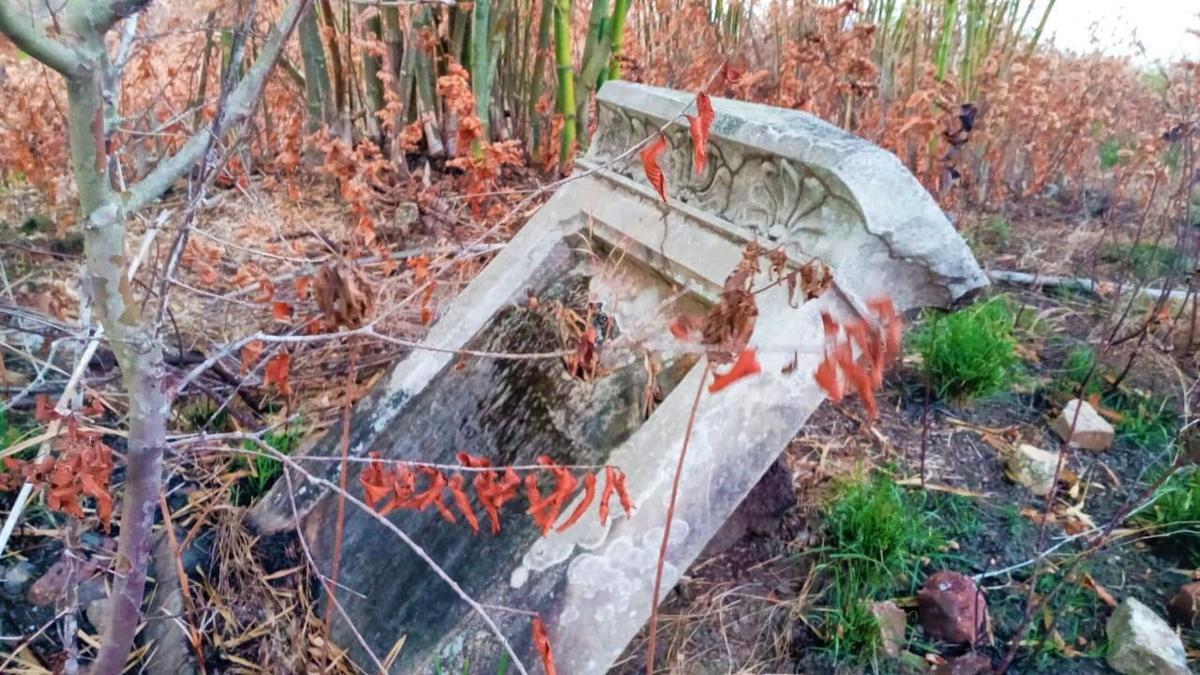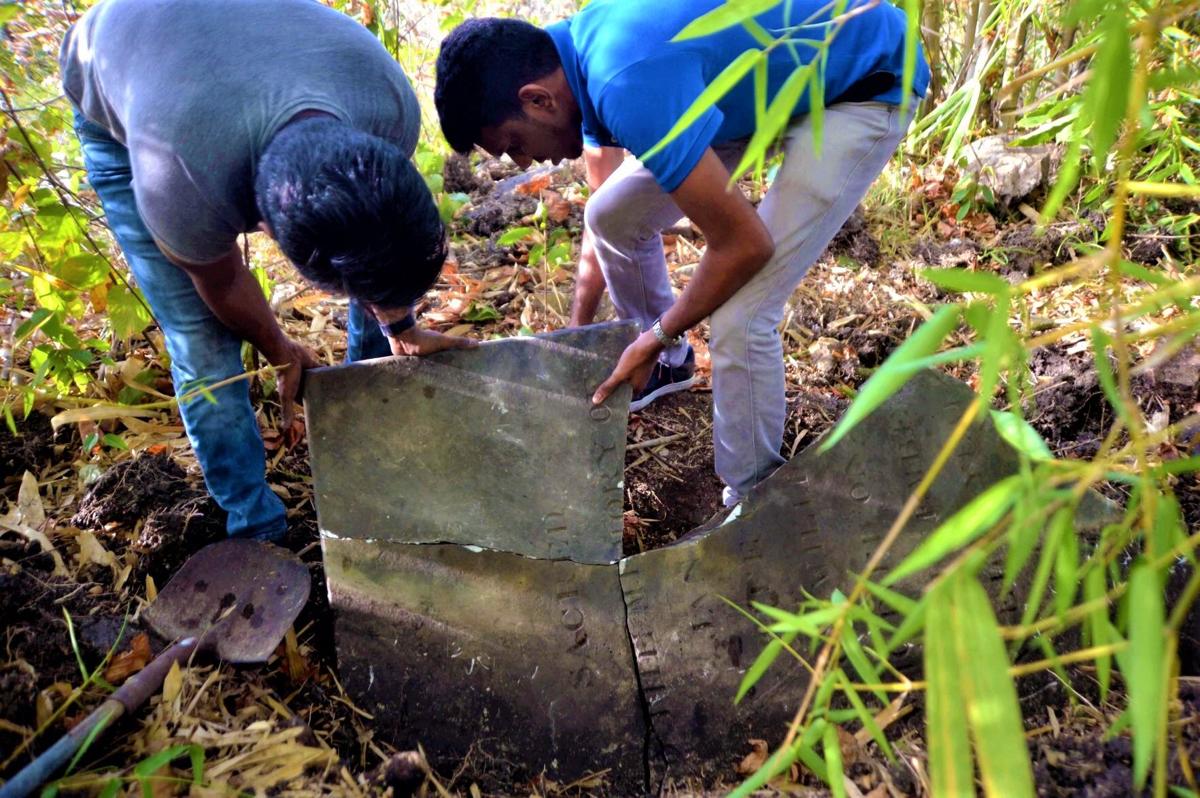 IF you were born in the community of Garth Road, Princes Town, you probably have heard about the “white man” tomb on Dragon Hill. But you also knew to keep far from it, given the number of jumbies, lagahoos and assorted local ghosts the old folks said were floating around up there, just waiting to follow you home. The hill also had the respect of the cane farmers who ploughed and planted the land, but who left untouched the gravesite in that bamboo grove. And for this we are thankful because it preserved a place that has opened the door to a lost piece of this island’s past. The tomb of concrete, marble, firebricks, and cast iron railing, we discovered, was erected there by Henry Stewart to mark the burial spot of his young wife and two infant children, who all died between 1842 and 1844. Stewart was a resident planter and slaveowner who, when Emancipation was proclaimed in 1834, continued his sugar business using the labour of the indentured Indian immigrants at least until the 1850s when he passes out of the historical records. How Stewart and his doomed family came to live and die in the south Naparimas of Trinidad is a story that time had erased, it appears. Secrets to share But Dragon Hill has other secrets to share, and one of it we found, by accident, mere metres from the Stewart family’s tomb. Hidden behind a tangle of bamboo and reaching through a carpet of dried leaves were broken slabs of blackened stone bearing the name “Jane”. She has been there for almost 200 years. This is why. It starts in the slave labour cotton plantations of North Carolina, USA, in the 1770s during the American Revolutionary War as the patriots fought the British to win their independence from the Crown, while also battling the Loyalists—the Americans who remained faithful to the British Empire. Among those who stayed faithful to King George III was the Williams’ family, who rounded up their slaves and moved to Florida until it became a Spanish territory. So they would move on to the British-owned islands of the Bahamas (north of Cuba) where the Williams brothers were granted lands to start a plantation on an island known as Watlings (now San Salvador). Here, one of the brothers, Burton Williams, amassed more than 300 slaves by the early 1800s. But according to the historical records, Williams claimed that his cotton fields were not prospering in the lean soil of the island, and he couldn’t afford to feed or clothe them for much longer. So in 1821, Williams was granted land in British-owned Trinidad which was then offering inducements to planters to relocate to this island and develop its plantation economy. And over a period of two years, the cargo of 324 human livestock would be shipped across the West Indies by Williams. Our ancestors would have arrived, no doubt, off San Fernando and be marched miles inland across mud roads made impassable during the rains, to their new place of misery. Williamsville, named for him Three estates were developed by Williams for his sons, including Picton (near present day Debe) and Cupar Grange (near Victoria Village, San Fernando). The largest one (300 acres) he named in his honour—Williamsville—which bordered the estate of Garth, south of what is now Princes Town. This area of Savanna Grande, in the fertile south Naparimas, is where Williams settled, building his plantation mansion on a hilltop and overseeing the clearing of the woodland for the planting of sugarcane, and for a cattle farm. Some evidence of this is still found by farmers tilling the surrounding land—bricks, broken pottery, coins and rusted metal of early buildings and sugar works. Evidence of the lives of the Williams’ slaves was also preserved in the records of the British and documented by researchers who found that in Trinidad, they suffered ailments, a poorer diet, lower birth rates and broken family life on a scale much higher than when they lived on their Bahamas island prison. Some of these slaves would be returned to the Bahamas. Of those who remained, some survived to see Emancipation, allowing them to walk off the plantations and start their own settlements (one given the name Hard Bargain after two such settlements in the Bahamas). As for Burton Williams, history records him as living a remarkably long life for the time, but suffering an ultimately miserable demise. As part of the British Empire’s Emancipation compensation to the slaveowners for the loss of their assets, he was paid 851 pounds, eight shillings and one pence for the 80 slaves he owned in the Bahamas. One of his sons, Sir Edward Eyre Williams, ended up becoming a celebrated high court judge in Australia after collecting his Trinidad slave money. Another ended up in a “lunatic asylum” in Kensington, London, so someone else had to claim his share of the spoils, according to the records. As for old man Burton, his Williamsville estate would be acquired by Henry Stewart, who of course would endure his own personal torment. And Burton Williams would return to Watling’s Island (San Salvador) in the Bahamas, never to see Trinidad again. Much has been written about this “Last Loyalist” in a book titled Homeward Bound, A History of the Bahamas Islands (Sandra Riley) where it is recorded, “Reduced from affluence to poverty, Burton Williams eventually outlived all his sons to die at age eighty-three at Watlings in July 1852”, and “Foreseeing that there might be no tools left with which to dig his own grave when he died, he had dug it ahead of time, one of the limestone ridge. His foresight was wise for when this once energetic and rich man died at an advanced age, a Negro servant who only needed to shovel away the light leaf mould from the waiting grave...”. The researchers also suggested that the wife of Burton Williams, whom he married in April 1797, was buried next to him in that grave in San Salvador, which has become a tourist attraction. They were likely wrong about that. What we found buried in the leaves on Dragon Hill is the shattered marble tombstone, sitting atop a bed of bricks, dating most likely to 1822. So we dug it out of the ground, and put the pieces together. The gravestone reads, “Sacred, in the memory of Jane, wife of Burton Williams Esq, died September aged 42”. If you know more about the Williams family, you can contact the writer at [email protected]. (April 20, 2022)
1 Comment
Janine Jacques
8/14/2023 12:57:38 pm
Good Afternoon Richard
Reply
Leave a Reply. |
T&T news blogThe intent of this blog is to bring some news from home and other fun items. If you enjoy what you read, please leave us a comment.. Archives
May 2025
Categories
All
|


 RSS Feed
RSS Feed